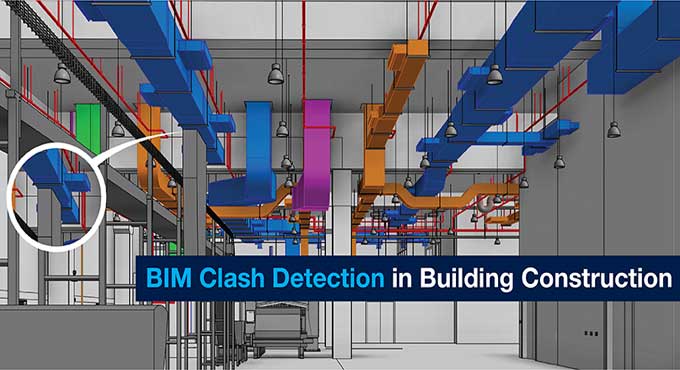The Clash Detection in BIM: its Benefits, Steps and Drawbacks
Tweet
In order to achieve the intended outcomes, successful collaboration between a number of stakeholders is necessary. There are a number of stakeholders involved in a construction design project today, including structural engineers, architects, contractors, suppliers, and vendors, which can make it quite difficult to complete the project.
What do you mean by BIM Clash Detection?
BIM Clash detection is a process used in building information modeling (BIM) that identifies conflicts or clashes between different building elements such as structural, mechanical, electrical, plumbing, and architectural systems.
The clash detection process involves taking the 3D models of each building system and comparing them to identify where components are interfering with one another. This could include instances where pipes intersect with beams, ductwork clashes with electrical conduits, or any other potential collision points that could result in design errors, construction delays, and additional costs.
The BIM Clash detection process helps to detect and address these conflicts early on in the design phase, thereby avoiding costly rework, delays, and potential safety hazards during construction. Clash detection can be done manually or through automated software tools that can quickly identify clashes and provide detailed reports for the design team to resolve the conflicts.
What are the Steps for Clash Detection in BIM?
The steps for clash detection in BIM typically involve the following:
1. Define Clash Detection Parameters: The first step is to define the parameters for clash detection. This includes the types of elements that need to be checked, the level of detail required, and the software or tools to be used for clash detection.
2. Identify the Building Elements: Next, all the building elements, such as walls, ceilings, floors, MEP (mechanical, electrical, plumbing) components, and other structural components, need to be identified and modeled in the BIM software.
3. Run the Clash Detection Software: Once the building elements are modeled, the clash detection software is used to identify potential clashes. The software runs automated tests to detect intersections or overlaps between different elements.
4. Review and Resolve Clashes: The software generates a report highlighting the potential clashes found. The design team then reviews the report and decides how to resolve the clashes. The solutions can be developed by making design changes or using alternative building components.
5. Re-run the Clash Detection Software: After making the changes, the clash detection software is run again to ensure that all the clashes have been resolved. This process may be repeated several times until all the clashes have been resolved.
6. Update the BIM Model: Once all the clashes have been resolved, the BIM model is updated to reflect the changes made. This updated model is then used for further design and construction processes.
It is essential to define parameters in BIM, identify building elements, use the software, review and resolve clashes, rerun the program, and update the BIM model in order to determine clashes.
What are the uses for Clash detection in BIM?
Here are some of the most common uses of clash detection in BIM:
1. Improved Coordination: Clash detection helps improve coordination among different teams working on a project. It identifies potential clashes between various building systems, such as HVAC, electrical, plumbing, and structural systems, before construction begins, allowing the teams to make necessary adjustments to avoid conflicts.
2. Time and Cost Savings: Clash detection can help save time and money during the construction process by identifying and resolving issues before construction begins. It reduces the likelihood of rework or change orders, which can add significant costs and delays to a project.
3. Enhanced Safety: Clash detection helps identify potential safety hazards and ensures that the building components are installed correctly, reducing the risk of accidents during construction and occupancy.
4. Improved Quality: Clash detection ensures that building components are accurately placed, reducing the likelihood of errors or omissions that could lead to quality issues or building failures.
5. Visual Communication: Clash detection generates visual reports, such as 3D models or clash detection reports, that help communicate potential issues to stakeholders, making it easier to understand and address conflicts.
What are some drawbacks for Clash Detection in BIM?
It is true that clash detection in BIM can greatly improve the efficiency of the construction process and prevent errors, but some drawbacks should be taken into account as well:
1. False positives: Clash detection software can sometimes generate false positives, which are clashes that appear to exist but are actually not problems in the real-world. These false positives can lead to unnecessary rework and delays in the construction process.
2. Limited scope: Clash detection is only as good as the information that is input into the software. If there are errors or omissions in the BIM model, clashes may be missed or not detected properly.
3. Coordination challenges: The clash detection process requires close coordination between all project stakeholders, including architects, engineers, contractors, and subcontractors. Without effective communication and collaboration, the process can become less efficient and less effective.
4. Time-consuming: The clash detection process can be time-consuming, particularly for large and complex projects. This can lead to delays and increased costs if clashes are not detected early in the design process.
To get online demonstration, watch the following video tutorial.
Video Source: United- BIM
5. Cost: The software and hardware required for clash detection can be expensive, particularly for small to medium-sized firms that may not have the resources to invest in the technology.
Final Thoughts
BIM clash detection is an important tool for improving coordination, saving time and money, enhancing safety, improving quality, and enabling effective visual communication. The process for clash detection in BIM involves defining parameters, identifying building elements, running the software, reviewing and resolving clashes, re-running the software, and updating the model.

Gallery
Feel free to contact us for BIM requirements. One of our representative will respond you within 24 Hours. Send us your projects requirement today and grow your project.
Explore More !







